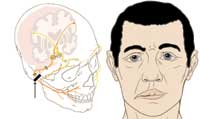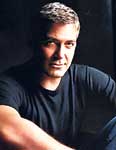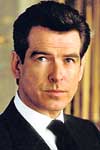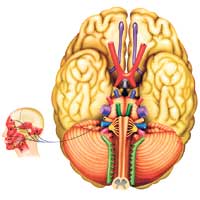
Facing facial palsyDo you know what could happen when your seventh nerve is affected? Amala came to office as usual that day. She had an ear-ache. Work on the computer preparing an urgent report was hectic, with the pain in the ear, while colleagues pointed out that one eye seemed odd. As there had been one or two cases of conjunctivitis (sore eyes) in the office, Amala assumed that she too had caught it and was preparing to leave for the doctor, when suddenly her speech became slurred and she felt something strange on her face. Quickly dipping into her handbag, she whipped out a small mirror and looked into it.
The image that stared back at her sent chills down her spine, leaving her scared and horrified - one side of her mouth had gone to a side, disfiguring her face. She also could not blink one eye. Taken to hospital by concerned colleagues who suspected that she may have suffered a stroke, it was a few days later that she and her family were told by doctors that her "seventh nerve was paralysed”. "It is one of the 12 pairs of cranial nerves branching directly from the underside of the brain. Most of the cranial nerves supply the head and neck area and contain sensory and/or motor nerve fibres," says Dr. Padma Gunaratne, Head of the Institute of Neurology (Unit II), National Hospital, Colombo, explaining that sensory fibres receive information from the outside world or internal organs, while motor fibres set off the contraction of voluntary muscles. Path of the facial nerve The facial nerve which is predominantly a motor nerve, arises from the facial nerve nucleus in the pons. Then it emerges from the brainstem between the pons and the medulla and tracks through a narrow space located inside the ear (internal auditory canal). Thereafter, the nerve passes through the middle ear (behind the ear drum) and leaves through another narrow passage located under the ear area (stylomastoid foramen). It then branches out to supply the muscles which help facial movements. The branches start inside the parotid gland (in front of the ear) and travel to the forehead, cheek, nose, mouth and neck.
No other nerve in the body travels such a long distance through a bony canal. The facial nerve stimulates the salivary glands, the lacrimal glands and carries fibres that are important for taste sensation in the front 2/3rd of the tongue and also the sensations experienced by the outer ear, MediScene understands. The lacrimal glands are paired glands, one for each eye, that secrete the aqueous layer of the tear film, while the salivary glands produce saliva. Voluntary facial movements, such as wrinkling the brow, showing teeth, frowning, closing the eyes tightly, pursing the lips and puffing out the cheeks are all enabled due to the facial nerve, says Dr. Gunaratne, adding that a malfunctioning facial nerve will affect the motor functions (movements) of the face. The facial nerve dysfunctions can be grouped into upper motor neuron dysfunction in which a patient develops weakness of the lower part of the face and lower motor neuron dysfunction causing paralysis of both the upper and lower parts of the face. The triggers for seventh nerve damage or trauma, which could affect anyone of any age, could be the nerve swelling up or some pressure on it to make it function abnormally, MediScene learns, leading to facial palsy. Bell's palsy, for which the etiology (cause or origin) is not known, is the commonest reason for facial palsy, while other rare causes are infections of the middle ear (Otitis Media) or Cholesteatoma (a skin growth in an abnormal location like the middle ear, behind the eardrum), tumours of the parotid gland, cancer deposits infiltrating the nerve underneath the angle of the jaw, facial and neck trauma and rarely as a complication after an operation in the ear area and (birth) abnormalities, says Dr. Gunaratne.
Herpes Zoster virus (chicken pox strain) is another culprit for facial nerve paralysis, she says, explaining that it can lie in a dormant state in a ganglion, but get activated due to an unknown reason or due to lack of sleep or stress, inflaming the nerve. This condition is called Ramsy Hunt Syndrome and the symptoms would be development of chicken pox blisters on the hard palate and in the inner part of the external ear, in addition to facial palsy. This should be treated with the anti-viral drug, Acyclovir. Hence, it is extremely important to check for blisters in the ear in patients with lower motor neurone facial palsy, stresses Dr. Gunaratne. Bell's palsy, one of the most common causes of facial nerve paralysis, she says, is most distressing to patients. What are the symptoms of Bell's palsy? This acute facial nerve paralysis, like in the case of Amala, would produce pain in the ear or behind the ear, occurring before symptoms of facial paralysis develop. The other symptoms that will follow are the deviation of the mouth, the mouth being dragged to one side, making people believe that the problem is on that side when actually, the paralysis has occurred on the other side of the mouth.
Difficulty in pronouncing words; accumulation of food in the mouth, drooling from the mouth, difficulty in closing the affected eye, would also be some of the symptoms. As the affected eye cannot close, dust and grit will settle in it, causing inflammation and redness, which would be a late symptom. And some of the famous sufferers of Bell's palsy include film actors and producers Pierce Brosnan and George Clooney, an internet search revealed. Assuring that in 85% of patients, there is spontaneous recovery, Dr. Gunaratne says even though in some, mild weakness may persist, it goes away ultimately. To hasten recovery, a course of Prednisolone along with physiotherapy may be ordered by the doctor. Occasionally, patients may experience hemi-facial spasms (twitching around the eye or near the cheek) as a late sequale of Bell's palsy. The treatment is cosmetic and will take the form of Botulinum toxin being injected to the area of the spasm, Dr. Gunaratne adds. |
|| Front
Page | News | Editorial | Columns | Sports | Plus | Financial
Times | International | Mirror | TV
Times | Funday
Times | Medi Scene || |
| |
Reproduction of articles permitted when used without any alterations to contents and the source. |
© Copyright
2007 | Wijeya
Newspapers Ltd.Colombo. Sri Lanka. All Rights Reserved. |



